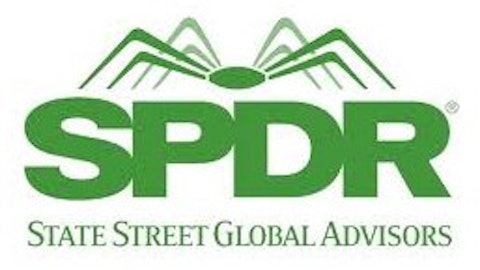Financial stocks had a remarkable year in 2012. Based on the Financial Select Sector SPDR (NYSEARCA:XLF), financials were the best performing sector last year, returning 23.4%. Despite the broad sector’s rally, some financial stocks remain undervalued. With growth prospects of the sector expected to improve in 2013, financials are likely to extend their gains further. The greatest potential for market-beating returns over the medium term have value stocks that pay high dividend yields.
Following value investor Chuck Royce’s disciplined value approach to stock selection, investors can identify plenty potential picks to achieve strong income and a value tilt in their portfolios. Based on Royce’s selection of financial stocks that comprise his namesake Royce Dividend Value Svc (MUTF:RYDVX), here is a list of five high-yield financials for 2013. These are high-yielding stocks that among Royce’s financial sector picks hold the largest shares in the noted fund.
KKR & Co. L.P. (NYSE:KKR) is a global private equity firm. Its stock has gained 17.4% over the past 12 months. The partnership’s yield is 6.2% and its payout ratio is 34%. Its distributions in 2012 were 18.3% higher than in 2011. The latest quarterly cash distribution was almost double the combined distributions of the previous two quarters. Nearly two thirds of the latest quarterly distribution came from carried interest, the partnership’s share in the funds’ profits. In fact, according to an Oppenheimer analyst, in 2013, KKR should have “a higher percentage of its private equity assets under management in a ‘cash carry’ mode than most of its peers.” Thus, distributions increases can be expected. KKR’s private equity funds gained 20% and its balance sheet investments added 22% in the first nine months of 2012 over the same period a year ago. The partnership is diversifying into credit, real estate, and hedge funds. Trading at 5.3x trailing and 6.8x forward earnings, KKR is cheaper than its peers. The partnership is popular with Arial Investment’s John Rogers.
Federated Investors Inc (NYSE:FII) is an asset manager offering a broad range of income-oriented funds. FII has rallied 34% over the past 12 months. Its dividend yields 4.5% on a payout ratio of 57%. Its regular dividends grew, on average, by 6.8% annually over the past five years, but the quarterly payout has been flat at $0.24 per share since 2008. In November 2012, the company paid a special dividend of $1.51 per share. FII’s long-term annual EPS CAGR is forecasted at 6.5%. Recently, the company has been surprising to the upside. Still, some concerns remain about the possible adverse impact on FII’s operations from the long-heralded money market reform that will aim to emphasize to investors the risks inherent in investing in money market funds. There are concerns investors will avoid money market funds, putting their money into banks. Federated receives 40% of its total revenue from money market funds. In terms of valuation, FII has a price-to-book below its historical averages. It is attractive based on the forward P/E of 11.6x, representing a 20% discount to its peer group. Fund manager Tom Gayner (Markel Gayner Asset Management) is a buyer of this stock.
Manning and Napier Inc (NYSE:MN) is a fast-growing and well-respected boutique asset manager. MN has gained 4.0% over the past year. Its dividend yields 4.8% on a payout ratio of 54% of forward earnings. The company started paying dividend in the second quarter of 2012. Given that almost all company’s assets under management are equity and asset allocation investment instruments, they may see stronger inflows this year as the threat of inflation drives money out of fixed-income assets and into equities. MN’s annualized EPS CAGR is forecasted at 8.0%. This debt free company is trading at 11.6x trailing and 11.1x forward earnings. On a forward P/E basis, the stock is trading at a 23% discount to its industry. Only a few fund managers have minor stakes in this stock, and one of them is Dmitry Balyasny.
AllianceBernstein Holding LP (NYSE:AB) is one of the largest institutional money managers with $419 billion in assets under management. AB’s stock has risen 32% over the past year. This MLP pays a high yield of 7.8%, compared to an average of 2.2% for its peer group. AB distributes almost all its annual income to unitholders. Its distributions in 2012 totaled $0.95 per unit, down 34% from 2011, but are expected to rebound to $1.49 per unit in 2013. The partnership’s earnings per unit (EPU) are forecasted to jump 17.4% this year, driven by accelerating organic growth, lower costs, and margin expansion. The stock offers a favorable risk/reward tradeoff relative to its peers. By investing in AB, investors get a double benefit from capital appreciation, driven by the bullish momentum in asset management stocks, and high income streams. Notwithstanding its trading at a new 52-week high, AB’s stock still has a forward P/E of 13.2%, representing a near-10% discount to its peer group. It is also trading at a below-industry price-to-book of 1.2. Fund manager John A. Levin (Levin Capital Strategies) holds a small position in AB.
Bank of Hawaii Corporation (NYSE:BOH) is a bank holding company with operations in Hawaii, Guam, and Pacific Islands. BOH is up more than 3% over the past year. Its dividend is yielding 3.9% on a payout ratio of 50%. Its dividends grew, on average, 3.4% per year over the past half-decade. The bank has a high ROE of 16.2%, which is 70% higher than the average rate for its industry. BOH is valued on a price-to-book of 2.0, double its industry’s ratio, but below the bank’s historical averages. The bank’s long-term annual EPS CAGR is 7.6%. BOH is well capitalized and adhering to prudent risk management. Improvements in non-interest income, loans and deposit growth, and credit quality have been driving earnings growth in recent quarters, despite net interest margin compression. The stock is priced below industry based on its trailing P/E of 12.3x. Value investor David Dreman also has a stake in BOH.





